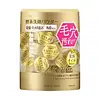What's inside
What's inside
 Key Ingredients
Key Ingredients

 Benefits
Benefits

 Concerns
Concerns

 Ingredients Side-by-side
Ingredients Side-by-side

Water
Skin ConditioningGlycerin
HumectantSodium Cocoyl Isethionate
CleansingGlyceryl Stearate
EmollientStearyl Alcohol
EmollientCoco-Betaine
CleansingLauramidopropyl Betaine
CleansingSodium Methyl Cocoyl Taurate
CleansingSodium Chloride
MaskingHydroxypropyl Starch Phosphate
Coco-Glucoside
CleansingCaprylyl Glycol
EmollientCitric Acid
BufferingMaltodextrin
AbsorbentMelia Azadirachta Leaf Extract
Skin ConditioningDisodium EDTA
Caramel
Cosmetic ColorantEryngium Maritimum Callus Culture Filtrate
Skin Conditioning1,2-Hexanediol
Skin ConditioningMelia Azadirachta Flower Extract
Skin ConditioningAchillea Millefolium Oil
CleansingHouttuynia Cordata Extract
Skin ConditioningIlex Aquifolium Leaf Extract
Skin ConditioningButylene Glycol
HumectantQuillaja Saponaria Bark Extract
CleansingHedera Helix Extract
AntimicrobialStreptococcus Thermophilus Ferment
HumectantAspergillus Ferment
Skin ConditioningTriticum Aestivum Seed Extract
PerfumingDna
Skin ConditioningGluconolactone
Skin ConditioningPanthenol
Skin ConditioningEthylhexylglycerin
Skin ConditioningMoringa Oleifera Seed Extract
Skin ConditioningLipase
Skin ConditioningProtease
ExfoliatingDipropylene Glycol
HumectantCalcium Chloride
AstringentHydrogenated Lecithin
EmulsifyingMadecassoside
AntioxidantMagnesium Sulfate
Asiatic Acid
Skin ConditioningAsiaticoside
AntioxidantMadecassic Acid
Skin ConditioningCentella Asiatica Extract
CleansingWater, Glycerin, Sodium Cocoyl Isethionate, Glyceryl Stearate, Stearyl Alcohol, Coco-Betaine, Lauramidopropyl Betaine, Sodium Methyl Cocoyl Taurate, Sodium Chloride, Hydroxypropyl Starch Phosphate, Coco-Glucoside, Caprylyl Glycol, Citric Acid, Maltodextrin, Melia Azadirachta Leaf Extract, Disodium EDTA, Caramel, Eryngium Maritimum Callus Culture Filtrate, 1,2-Hexanediol, Melia Azadirachta Flower Extract, Achillea Millefolium Oil, Houttuynia Cordata Extract, Ilex Aquifolium Leaf Extract, Butylene Glycol, Quillaja Saponaria Bark Extract, Hedera Helix Extract, Streptococcus Thermophilus Ferment, Aspergillus Ferment, Triticum Aestivum Seed Extract, Dna, Gluconolactone, Panthenol, Ethylhexylglycerin, Moringa Oleifera Seed Extract, Lipase, Protease, Dipropylene Glycol, Calcium Chloride, Hydrogenated Lecithin, Madecassoside, Magnesium Sulfate, Asiatic Acid, Asiaticoside, Madecassic Acid, Centella Asiatica Extract
Talc
AbrasiveMaltitol
HumectantSodium Cocoyl Isethionate
CleansingSodium Myristoyl Glutamate
CleansingSodium Lauroyl Glutamate
Sodium C14-16 Olefin Sulfonate
CleansingPotassium Laurate
EmulsifyingCarrageenan
Glycyrrhiza Glabra Root Extract
BleachingSqualane
EmollientCitric Acid
BufferingSodium Hyaluronate
HumectantHelianthus Annuus Seed Oil
EmollientPersea Gratissima Oil
Skin ConditioningBHT
AntioxidantDipropylene Glycol
HumectantSilk
Ethyl Glucoside
HumectantProtease
ExfoliatingLipase
Skin ConditioningSodium Benzoate
MaskingTalc, Maltitol, Sodium Cocoyl Isethionate, Sodium Myristoyl Glutamate, Sodium Lauroyl Glutamate, Sodium C14-16 Olefin Sulfonate, Potassium Laurate, Carrageenan, Glycyrrhiza Glabra Root Extract, Squalane, Citric Acid, Sodium Hyaluronate, Helianthus Annuus Seed Oil, Persea Gratissima Oil, BHT, Dipropylene Glycol, Silk, Ethyl Glucoside, Protease, Lipase, Sodium Benzoate
Ingredients Explained
These ingredients are found in both products.
Ingredients higher up in an ingredient list are typically present in a larger amount.
Citric Acid is an alpha hydroxy acid (AHA) naturally found in citrus fruits like oranges, lemons, and limes.
Like other AHAs, citric acid can exfoliate skin by breaking down the bonds that hold dead skin cells together. This helps reveal smoother and brighter skin underneath.
However, this exfoliating effect only happens at high concentrations (20%) which can be hard to find in cosmetic products.
Due to this, citric acid is usually included in small amounts as a pH adjuster. This helps keep products slightly more acidic and compatible with skin's natural pH.
In skincare formulas, citric acid can:
While it can provide some skin benefits, research shows lactic acid and glycolic acid are generally more effective and less irritating exfoliants.
Most citric acid used in skincare today is made by fermenting sugars (usually from molasses). This synthetic version is identical to the natural citrus form but easier to stabilize and use in formulations.
Read more about some other popular AHA's here:
Learn more about Citric AcidDipropylene Glycol is a synthetically created humectant, stabilizer, and solvent.
This ingredient helps:
Dipropylene glycol is technically an alcohol, but it belongs to the glycol family (often considered part of the ‘good’ alcohols). This means it is hydrating and gentle on skin unlike drying solvent alcohols like denatured alcohol.
As a masking agent, Dipropylene Glycol can be used to cover the smell of other ingredients. However, it does not have a scent.
Studies show Dipropylene Glycol is considered safe to use in skincare.
Learn more about Dipropylene GlycolWe don't have a description for Lipase yet.
These enzymes break down protein into smaller peptides and amino acids. They also encourage the formation of new protein.
Our skin uses peptides, amino acids, and protein for maintaining healthy skin cells.
Protease work by breaking peptide bonds in protein with hydrolysis. This is the process of breaking bonds using water.
An in-vitro study (not done on a living organism) found a blend of 3-protease decreases skin inflammation by mitigating the effects of other proteins.
One manufacturer that uses subtilisin, a protease from Bacillus subtilis, claims this ingredient is exfoliating, promotes cell regeneration, and is a good substitute for AHAs. Further research is needed to back up these claims.
Fun fact: The human body contains ~641 protease genes.
Learn more about ProteaseSodium cocoyl isethionate is a natural ingredient from coconut oil. It is an ultra gentle cleanser that gives a nice foam without drying the skin or impacting the skin barrier.
The amount of foam created depends on the amount of sodium cocoyl isethionate used in the product.
This ingredient also helps improve the spreadability of a product.
Learn more about Sodium Cocoyl Isethionate